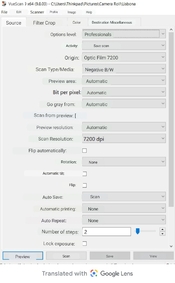Hi everyone, happy to have joined the forum.
Started scanning with a used plustek 7200 that I've recently bought on ebay, using vuescan as software. I don't understand if these dots are just film gran or some sort of bad scanning. Any way to solve this issue? Or is it normal? Thanks!! Posting a zoomed-in section of a recent scan.
Started scanning with a used plustek 7200 that I've recently bought on ebay, using vuescan as software. I don't understand if these dots are just film gran or some sort of bad scanning. Any way to solve this issue? Or is it normal? Thanks!! Posting a zoomed-in section of a recent scan.







 Preferably photographed with the negative held against a diffuse light. Your monitor with a white page in Word etc. usually does fine to get a quick impression of the negative.
Preferably photographed with the negative held against a diffuse light. Your monitor with a white page in Word etc. usually does fine to get a quick impression of the negative. 